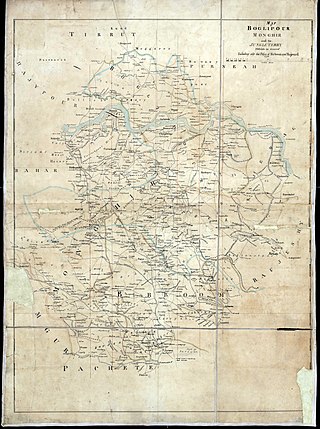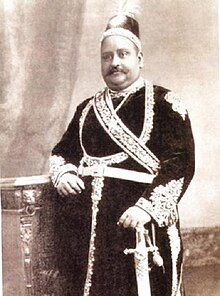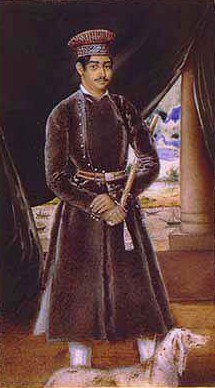Nawab, also spelled Nawaab, Navaab, Navab, Nowab, Nabob, Nawaabshah, Nawabshah or Nobab, is a royal title indicating a sovereign ruler, often of a South Asian state, in many ways comparable to the western title of Prince. The relationship of a Nawab to the Emperor of India has been compared to that of the Kings of Saxony to the German Emperor. In earlier times the title was ratified and bestowed by the reigning Mughal emperor to semi-autonomous Muslim rulers of subdivisions or princely states in the Indian subcontinent loyal to the Mughal Empire, for example the Nawabs of Bengal.

A jagir, also spelled as jageer, was a type of feudal land grant in the Indian subcontinent at the foundation of its Jagirdar (Zamindar) system. It developed during the Islamic era of the Indian subcontinent, starting in the early 13th century, wherein the powers to govern and collect tax from an estate was granted to an appointee of the state. The tenants were considered to be in the servitude of the jagirdar. There were two forms of jagir, one conditional, the other unconditional. The conditional jagir required the governing family to maintain troops and provide their service to the state when asked. The land grant, called iqta'a, was usually for a holder's lifetime; the land reverted to the state upon the death of the jagirdar.
Pargana or parganah, also spelt pergunnah during the time of the Sultanate period, Mughal times and British Raj, is a former administrative unit of the Indian subcontinent and each parganas may or may not be subdivided into pirs. Those revenue units are used primarily, but not exclusively, by the Muslim kingdoms. After independence the Parganas became equivalent to Block/ Tahsil and Pirs became Grampanchayat.

The Bardhaman Raj, also known as Burdwan Raj, was a zamindari Raja estate that flourished between 1657 and 1955 in the Indian state of West Bengal. Maharaja Sangam Rai Kapoor, a Punjabi Khatri from Kotli mahalla in Lahore, Punjab, who was the first member of the family to settle in Bardhaman, was the original founder of the house of Bardhaman, whereas his grandson Abu Rai, during whose time the zamindari started flourishing, is considered to be the patriarch of the Bardhaman Raj family.
The Singranatore family is the consanguineous name given to a noble family in Rajshahi of landed aristocracy in erstwhile East Bengal and West Bengal that were prominent in the nineteenth century till the fall of the monarchy in India by Royal Assent in 1947 and subsequently abolished by the newly formed democratic Government of East Pakistan in 1950 by the State Acquisition Act.
The Darbhanga Raj, also known as Raj Darbhanga and the Khandwala dynasty, was a Maithil Brahmin dynasty and the rulers of territories, not all contiguous, that were part of the Mithila region, now divided between India and Nepal.
The region have been inhabited since the Stone Age. Copper tools from the Chalcolithic period have been discovered. This area entered the Iron Age during the mid-2nd millennium BCE.

The Sonbarsa Raj was a medieval chieftaincy and later a zamindari (estate) during British Raj in modern-day Bihar, in erstwhile Bhagalpur district. It was controlled by the Gandhwaria Rajput.

The Tekari Raj was a zamindari estate of the Bhumihar community in South Bihar. They controlled 2,046 villages on their estate, which covered a 7,500 square kilometres (2,900 sq mi) area, near to the town of Gaya.

The East Bengal State Acquisition and Tenancy Act of 1950 was a law passed by the newly formed democratic Government of East Bengal in the Dominion of Pakistan. The bill was drafted on 31 March 1948 during the early years of Pakistan and passed on 16 May 1951. Before passage of the legislature, landed revenue laws of Bengal consisted of the Permanent Settlement Regulations of 1793 and the Bengal Tenancy Act of 1885.

The Zamindars of Bengal were zamindars of the Bengal region of the Indian subcontinent. They governed an ancient system of land ownership.

Zamindars of Natore were influential aristocratic Bengali Zamindars, who owned large estates in what is today Natore District in Bangladesh .
Rai is a historical title of royalty and nobility in the Indian subcontinent used by rulers and chieftains of many princely states. It is derived from Raja (king). The Marathi/Telugu variant Rai was used as a substitute to King.
The Jat people are a traditionally agricultural community in Northern India and Pakistan. Originally pastoralists in the lower Indus river-valley of Sindh, many Jats migrated north into the Punjab region in late medieval times, and subsequently into the Delhi Territory, northeastern Rajputana, and the western Gangetic Plain in the 17th and 18th centuries. Of Hindu, Muslim and Sikh faiths, they are now found mostly in the Indian states of Punjab, Haryana, Uttar Pradesh and Rajasthan and the Pakistani provinces of Sindh and Punjab.
The Nagvanshis of Chotanagpur, also known as the Khokhra chieftaincy, was an Indian dynasty which ruled the parts of Chota Nagpur plateau region during much of ancient, medieval and modern period. Phani Mukut Rai is considered the first king of dynasty claim to be son of Pundrika Naga, a mythical Naga. Lal Chintamani Sharan Nath Shahdeo (1931–2014) was last ruling king of the dynasty, until the estate was merged to the Republic of India.

Jhargram Raj was a zamindari which occupied a position in Bengal region of British India. The zamindari came into being during the later part of the 16th century when Man Singh of Amer was the Dewan/Subahdar of Bengal (1594–1606). Their territory was centered around present-day Jhargram district. Jhargram was never an independent territory since the chiefs of the family held it basically as the zamindars of the British Raj in India after Lord Cornwallis's Permanent Settlement of 1793. Although its owners were both rich and powerful, with the chiefs of the family holding the title of Raja, the Jhargram estate was not defined as a Princely State with freedom to decide its future course of action at the time of Indian independence in 1947. Later, the Vice-Roy of India agreed to recognize Jhargram as "Princely State" after the Second World War, but the proposal taken back as the British had decided to give independence to India.

Kharagpur Raj was a prominent chieftaincy, founded in the early 16th century in Bihar situated mainly in modern-day Munger district. They were notable for being one of the few chieftaincies in Bihar to convert to Islam and many of the rulers became firm allies of the Mughal authorities. At its peak, the Kharagpur Raj encompassed parts of the modern-day districts of Munger, Bhagalpur, Jamui, Lakhisarai, Godda and Deoghar. Due to its size, the Privy Council compared it with the Kingdom of Sardinia.

The Zamindars of Bihar were the autonomous and semi-autonomous rulers and administrators of the Mughal subah of Bihar and later during British rule. The zamindars of Bihar were numerous and could be divided into small, medium and large depending on how much land they controlled. Within Bihar, the zamindars had both economic and military power. Each zamindari would have their own standing army which was typically composed of their own clansmen.

The Gidhaur Chieftaincy was a principality which controlled parts of South Bihar for much of the medieval period in India. The chieftaincy was named after the town of Gidhaur in Jamui district but its territory extended into the wider region.












